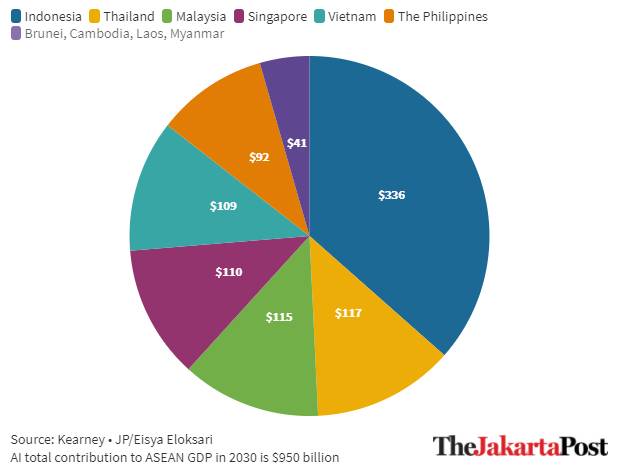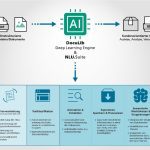AI to bring in $366b to Indonesia’s GDP by 2030. Artificial intelligence (AI) could add US$366 billion to Indonesia’s gross domestic product in the next decade and almost $1 trillion in added GDP across Southeast Asia, a recent study has shown.

The study by consulting firm Kearney and Singapore-based investment firm EDBI says that 80 percent of respondents are still in the early stages of AI adoption, lagging two to three years behind the United States and China.
“Just like in many countries, financial services and retail have been the early adopters of AI in Indonesia. We are also seeing a lot of potential in the logistics and supply chain sector,” Kearney senior partner Soon Ghee Chua said in a press briefing on Thursday.
The study pointed out that Indonesian e-commerce platform Tokopedia was able to increase the total number of transactions by 202 percent and increase revenue by 179 percent month-over-month after implementing AI-based product recommendations.
AI usage in Southeast Asia is mainly for marketing and sales, followed by supply chain and manufacturing. However, the finance industry has also used AI to decrease fraudulent transactions while human resources utilizes AI to increase candidate matching.
AI is expected to uplift GDP across Southeast Asia in 2030
AI contribution to the region’s GDP is expected to reach almost $1 trillion
*number in billion US$

Thirty-three percent of respondents said that they were reluctant to implement AI over concerns of employee backlash from job displacement, making it one of the challenges of AI adoption.
“There is always a concern over that issue, but in the near term AI is mostly used for augmentation of human tasks rather than the replacement of human abilities,” he said, adding that most AI was used to generate revenue, as opposed to cutting costs, for example, through layoffs.
The government and businesses, he added, could roll out teaching programs for university students and employees to learn about preparing data and using algorithms that were crucial for operating AI. “Companies are not looking for people who can develop the next groundbreaking AI.
It’s about [employees] picking up skills to use in AI rather than becoming an AI algorithm writer,” he said.
Similarly, Nikolai Dobberstein, Kearney Asia Pacific communications, media and technology head, said that upskilling programs could solve the talent gap as more than 85 percent of respondents highlighted difficulties in finding talents for AI-related activities.
“We believe this talent gap issue is overstated because we are seeing a significant improvement in AI models in recent years. They are more readily available and easier to deploy,” he said.
Dobberstein went on to say that companies should also prioritize focused AI initiatives for near-term impact with an employee-centric approach to build momentum for deploying AI at scale.
“AI is not a panacea. You need to develop it for specific use cases and to solve business pain points,” he said, advising governments to develop national AI agendas that prioritized adoption in key sectors.
The Research and Technology Ministry and the National Research and Innovation Agency (BRIN) launched in August a national strategy for developing AI. It will focus on education and research, health services, bureaucratic reform, food security, mobility and smart cities.
The government has also put AI utilization in the country’s latest five-year plan for digital transformation, along with 5G infrastructure development.
“Laypeople think of 5G as only increased bandwidth, but it can also enable a massive internet of things (IoT) and the IoT is most beneficial in automation,” said EDBI managing partner Basil Lui during the online press conference. A recent study by the Bandung Institute of Technology’s Industrial and Research Affiliation Institution showed that 5G can add Rp2.8 quadrillion ($188 billion) to the Indonesian economy by 2030 once the government releases its 5G spectrum for the 2021-2023 period. AI usage in Southeast Asia is mainly for marketing and sales, followed by supply chain and manufacturing. AI to bring in $366b to Indonesia’s GDP by 2030 (Eisya A. Eloksari, The Jakarta Post)





 Membedah Dokumen Ribet Secara Analistis, Bagaimana Artificial Intelligence Membantu?
Membedah Dokumen Ribet Secara Analistis, Bagaimana Artificial Intelligence Membantu? 